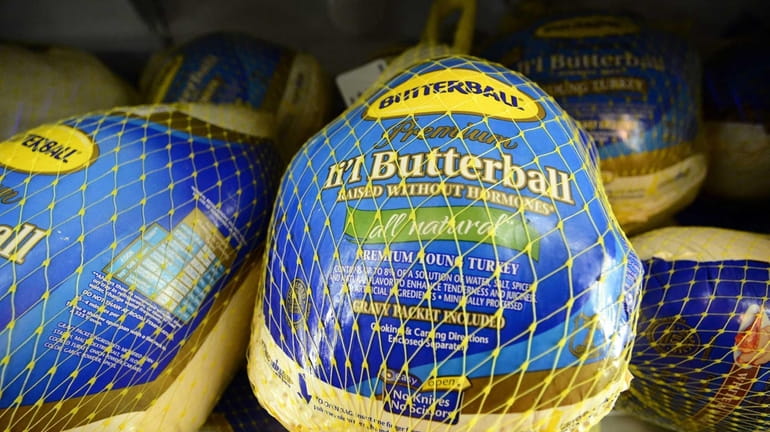Leonard: The problem with eating turkey

A frozen Butterball turkey on sale for Thanksgiving. (Nov. 18, 2013) Credit: Newsday / Thomas A. Ferrara
Turkey is America's most political meat.
Every Thanksgiving, a roasted turkey anchors the meal at which we pay homage to the Pilgrims and give thanks for our country's prosperity and freedom. The president pardons a bird in the Rose Garden. And Ben Franklin even compared the turkey favorably to the bald eagle in a letter to his daughter: "For the Truth the Turkey is in Comparison a much more respectable Bird, and withal a true original Native of America . . . a Bird of Courage."
The turkey tells a story about our nation. But today, the story of turkey in America has seen independence replaced by servitude, and open markets by opaque contracts. If the Pilgrims had seen this coming when they sat down for the first Thanksgiving, they would have lost their appetites.
Just four corporations - Cargill, Hormel, Butterball and Farbest Foods - produce more than half of the turkey in the United States, a level of concentration unthinkable just a few decades ago. Even in the 1970s, the meat industry was defined by competition among dozens of companies that worked with independent farmers. But all that disappeared when a handful of corporations gobbled up their competitors and took control of the farms and slaughterhouses that make our meat.
Today, just three companies produce nearly half the chicken in the United States, according to a market breakdown provided by Tyson Foods. Four companies make about 84 percent of our beef, while four companies produce 64 percent of our pork, according to the most recent data from the U.S. Department of Agriculture (USDA). The industry is effectively divvied up between four big meatpackers: Tyson Foods, JBS, Cargill and Smithfield Foods.
You don't have to be a Pilgrim to know that unchecked power rarely goes unused. The days of falling prices are gone. Meat prices jumped more than 7 percent in 2011 and more than 3 percent last year, and the USDA estimates that prices are continuing to rise steadily and could increase as much as 3.5 percent next year. Consumers pay more, farmers earn less, and companies in the middle reap a windfall from the difference.
Don't blame the poor turkey. The takeover of America's meat industry began with its less-prestigious cousin, the chicken. Starting around the 1940s, chickens were removed from America's farms and pressed into the service of a new meat system that can only be described as feudal.
In this industrial system, chickens are born in roosts where their eggs drop onto conveyor belts and are then shipped to giant hatcheries, after which the chicks are raised in warehouse-like barns and slaughtered in processing plants modeled on Henry Ford's assembly line. Industrializing the chicken's life cycle allowed poultry companies such as Tyson Foods to gain unprecedented control over mass animal production. From a central office in Springdale, Ark., Tyson can control what kinds of birds are raised, what they are fed and when they are slaughtered.
Here is what modern poultry farming looks like: A farmer will borrow several hundred thousand dollars (or in some cases millions) to build industrial barns where the birds will be raised. The birds themselves are never bought or sold on an open market; a poultry company delivers chicks to the farm and picks them up about six weeks later when the birds are big enough to slaughter. Farmers are kept on short-term contracts with the big poultry companies and live in fear that they'll be dropped.
I spent several years touring chicken farms, cattle feedlots and industrial pork barns throughout the Midwest while researching the meat industry. Consumers are paying near-record-high prices for meat these days. Turkey prices have jumped about 47 percent since Thanksgiving 2007, even after adjusting for inflation, to $1.82 per pound. Beef prices rose 16 percent during that period to about $4.98 per pound, while pork increased 20 percent to $3.81 per pound.
Inflation-adjusted meat prices have been higher, but we have to go back decades - most recently in the 1970s, when grain prices skyrocketed. After that crisis, industrialization gave consumers a big, one-time price drop. However, prices have been rising steadily over the past decade, as the industry consolidated.
Even with rising prices, poultry farmers are living on the edge of bankruptcy. I sat in the living rooms of farmers who were working for free because poultry companies didn't pay them enough to cover the cost of farming. A lot of them took raw deals with the companies for no better reason than they loved their hometowns and there weren't any better opportunities around.
Yet, the operating profit margins of the top four meatpackers rose steadily between 2007 and 2010, even as the economy stagnated, according to USDA data. Between 2009 and 2010, operating profit margins for the Big Four meat companies more than doubled to 4.5 percent. This past week, Tyson Foods reported that it earned a record $778 million in profit last year as it raised prices for beef, pork and chicken.
Of course, it doesn't have to be this way. There are people willing to make a different world, even within the confines of the modern meat oligarchy.
Back in 2004, Sonny Meyerhoeffer was a turkey farmer near Hinton, Va., laboring under a contract that gave him very little autonomy. The poultry company he worked for was called, yes, Pilgrim's Pride. That year, the company announced that it would close its slaughterhouse in Hinton, canceling its contracts with Meyerhoeffer and his neighbors. The decision seemed to sentence the farmers to bankruptcy. There's not much you can do with an industrial turkey barn other than raise turkeys. Without a contract, the farmers weren't left with anything besides their massive debts.
But instead of giving up, Meyerhoeffer and his fellow farmers formed the Virginia Poultry Growers Cooperative and scraped together more than $2 million, borrowing $8 million more from the USDA. With that, they bought the Pilgrim's Pride turkey slaughterhouse. The farmers now supply and own the slaughterhouse. Farmers gave themselves the right to fire the plant's managers if they felt they were mistreated. They formed an advisory committee to ensure that they had a voice in decision-making. In their own small way, they established a new political and economic order in the turkey business.
Meyerhoeffer and his neighbors aren't becoming millionaires off the deal, but they do possess something that is the envy of contract poultry and hog farmers around the country. They have dignity and autonomy.
If other pilgrims follow Meyerhoeffer's example, it could inject competition into the meat business and give farmers more freedom. And that's something to which we should also raise a cup around this year's Thanksgiving table.
Leonard, a former national business reporter with the Associated Press, is a fellow at the New America Foundation and the author of the forthcoming "The Meat Racket: The Secret Takeover of America's Food Business."

